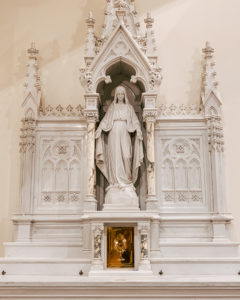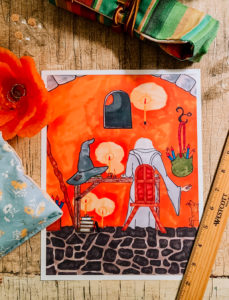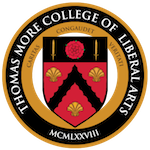by Bridget Ruffing, ’22

The education that Thomas More College offers to its students is one that is not meant merely to be received: it is meant to be lived. The school seeks to provide its students with a strong foundation in knowledge that both appertains to and augments a truly humane way of life.
Recent graduate Jacinta Yellico of the class of 2020 is a shining example of how a liberal arts education can fruitfully inform a life spent pursuing the good. She has embraced her call to see and create beauty in every aspect of her life: whether she is working on restoration projects, bringing the beloved tales of her favorite authors to life with vivid illustrations, or playing music that connects her to a rich folk tradition, Jacinta is always putting her education to good use.
Jacinta’s time at Thomas More helped her to cultivate her creative gifts, and now she gladly shares them with her friends, her family, and her community. She was kind enough to take some time to describe what she’s been up to since graduating and what the future might have in store for her.
Since graduating, you have spent time traveling across the country to work on various altar restoration projects in Catholic churches. Could you describe what the process of working on a restoration project might look like on a given day?
 Altar restoration and construction is a fascinating and wonderful work. It largely consists of erecting altars, some of which are new and others many years old. These older altars need cleaning and polishing before being erected. The best way to describe this process is to liken it to putting together a puzzle: each altar piece is numbered and put in one of many crates. Each crate is designated to hold a particular part of the altar (i.e., the left side, the front, the right side, etc.). My job is to find the correct pieces, lay them out in order, and then clean them.
Altar restoration and construction is a fascinating and wonderful work. It largely consists of erecting altars, some of which are new and others many years old. These older altars need cleaning and polishing before being erected. The best way to describe this process is to liken it to putting together a puzzle: each altar piece is numbered and put in one of many crates. Each crate is designated to hold a particular part of the altar (i.e., the left side, the front, the right side, etc.). My job is to find the correct pieces, lay them out in order, and then clean them.
The cleaning process is much like sanding wood, but I use a grit paper specifically suited to marble. After using this paper to remove the build-up of what sometimes consists of years of wax, soot, and dirt, I polish the piece with a similar sanding technique using a paper with a progressively finer grit. Many of the pieces are incredibly ornate, so they must be cleaned with brushes designed to reach into small spaces. While some of the restoration crew is cleaning and polishing, other members are working to construct breathtaking high altars, side altars, and baptismal fonts, all from the ground up.

While working on an altar restoration project, one can see and appreciate every detail up close. In some instances, one is re-constructing an altar that countless Masses have been celebrated on. Such an experience is truly surreal and beautiful, to say the least. This is my favorite of all the jobs I’ve ever had, and I do hope I’ll have the opportunity to partake in the restoration of many more churches in the future.
You have been involved in many other artistic pursuits since graduating, including drawing and photography. Would you say that your time at Thomas More has helped you to develop or recognize these skills in any way? If so, how?
I would like to thank my parents for being great creative influences on me and encouraging me to grow in my love for the arts. This encouragement gave me a vital foundation to build from once I began attending Thomas More. The Way of Beauty and Art and Architecture classes were some of my favorite courses I took during my time at the school. These courses taught me both why a thing is beautiful and the history of that piece. This knowledge, which I acquired while immersed in the interactive experience which is central to both classes, holds as much importance for me as the work itself. These classes exposed me and my classmates to a plethora of works in diverse styles. It was a truly wonderful experience to see how each individual artist returned his God-given gift to Him in an act of praise. That’s what fascinates me about art: the varied types of art that I have grown to love have always reminded me—whether I’m acting in the role of a viewer or a reader or some other appraiser—of God.
Has your education been of benefit to you as you approach your life and make decisions after graduation?
Yes, in myriad ways. While attending Thomas More, I had the opportunity to meet many like-minded individuals. Here, the chance to build real, meaningful friendships was placed before me. Not only did I find many good-hearted people to share my thoughts and passions with, but I was provided with a classroom experience that placed an emphasis on the importance of who you choose as a friend. This emphasis was supported and re-enforced by the everyday life on campus. That was one of the most important and encouraging aspects of my education: I and the other members of the community were shown how admirable a life lived in accordance with truth, goodness, and beauty is. All the while, I was growing in friendship with those who want to pursue that same goal and share it with others. It was encouraging and uplifting to be a member of such a community, and it only gave me more incentive to persevere in my pursuit of the good.
Can you offer any insight into what might be next for you? Do you have any goals or hopes for the next few years?

It has been my goal for a while to sit down and make a recording of classic folk songs, and hopefully a few of my own. This will be quite an involved process, but it is one I look forward to and enjoy planning for.
The painting and drawing that I do has been more of a hobby, but I would like to continue selling my work. More importantly, I would like to continue to enjoy creating it. Much of my artwork consists of pieces inspired by the works of J.R.R. Tolkien, but I am surrounded by other inspiration for paintings and drawings. I think I can safely say that my supplies will run out long before the ideas!
On another, important note, my cousins, siblings, and I have long upheld our tradition of venturing out the day after Christmas to bring food, beverages, blankets, etc. to the homeless in nearby towns and give them some company if they would like it. Our hope is to do this more often than once a year, so another plan I have for the near future is to arrange to bring comfort to those in need more often—perhaps every month.
For further reading:
Painting, Poems, and Pageants: Guildmaster John Folley and the Sacred Art Guild
